Keeping things organized and running smoothly is key to a successful homeschooling journey. And one important aspect of that is managing and tracking attendance. That’s why we’ve created a set of free printable homeschool attendance sheets for you to download.
But how do you use them? In this blog post, we’ll walk you through the process of creating a homeschool attendance calendar that fits your homeschooling needs and desires. Let’s dive in and get your homeschool planning off to a fantastic start!
*Note: This post contains affiliate links, which means I receive a small commission, at no extra cost to you, if you make a purchase using the link. Please see my disclosure for more details.

Why plan your annual homeschool attendance
It’s helpful to plan your annual homeschool attendance in advance. It gives you a framework to work from as you go through your year. You can easily know when you can have some free days, and when you need to buckle down and do your work. It also is helpful for ensuring you finish all you plan to do in the school year and meet legal requirements.
Read: Homeschool Attendance Records: Days and Hours (The Ultimate Guide)
When you don’t plan out your days for the year, you may take a lot of days off, then reach what you think is the end of the school year and you are nowhere near finishing your curriculum. Or you may want to take a trip but not be sure if you can afford to take the days off school.
Planning out your school days helps give some structure to your year and helps you have some consistency with your schedule. It allows the whole family to know what to expect in the months to come.
For more information on all the ins and outs of making and keeping attendance records, check out my post about Homeschool Attendance Records here.
Free Printable Homeschool Attendance Sheets
My free printable homeschool attendance sheets have been curated specifically for planning out your homeschool year. These worksheets not only walk you through the steps necessary to plan attendance, but also give you a calendar to reference throughout the school year.
These worksheets are designed specifically for using the steps in this article. So download it for free today!
With ten pages included and multiple calendar layouts, you will be able to set yourself up for success without any guessing.
Start with the attendance planning worksheet, then move to marking out a calendar following the steps in this post. Reference your calendar throughout the year, and you will never question your school days again!
How to plan your annual homeschool schedule
Set aside a few minutes, print out the free attendance sheets, and work through the following steps with me. In just a few minutes you will have a good annual plan for your homeschool year!
A couple tips to get started:
- Print out the free printable homeschool attendance sheets
- Fill out in pencil or erasable pen in case you make a mistake
- Print multiple copies of the calendar in case of mistakes
- Use a final draft of the calendar to reference throughout the year
- Track your daily attendance – highlighters work well
- Feel free to adjust as needed throughout the year

1. Use my Attendance Planning Sheet
As part of my homeschool attendance sheets, I have designed a great worksheet to gather necessary info as you plan your attendance. Using this page will help you come up with all the information you need to complete the rest of the steps below. It’s a great reference page to use as you plan out your year on the calendar.
Using the worksheet is a great first step in this process. Download the form here.

2. Check your legal requirements
One of the first things you need to do when thinking through your homeschool year is to check your legal requirements for homeschooling. As for attendance, your state may require a certain number of days to homeschool. Some also require tracking hours.
I like to note this number on my attendance planning worksheet. This page is included with my free printable attendance sheets found here.
A great place to check this out is on the Homeschool Legal Defense Association’s (HSLDA) website. On this site, you will find all kinds of legal information for homeschoolers as well as links to a breakdown of each state’s laws. There are also direct links to the actual wording from your State’s Department of Education.
Many states will also have state or regional Homeschool Associations that will give support to homeschoolers. Many of these associations will include interpretations of the state laws along with some guidance to follow them on their website. This site should be easy to find in your state using a search engine.
It is important as a homeschooler that you read the law yourself rather than relying on others’ interpretations. Often local homeschoolers may not understand them correctly or give misguided information. So do your due diligence as an independent homeschooler and find out specifically what is required of you. Perhaps print them out for reference as needed.
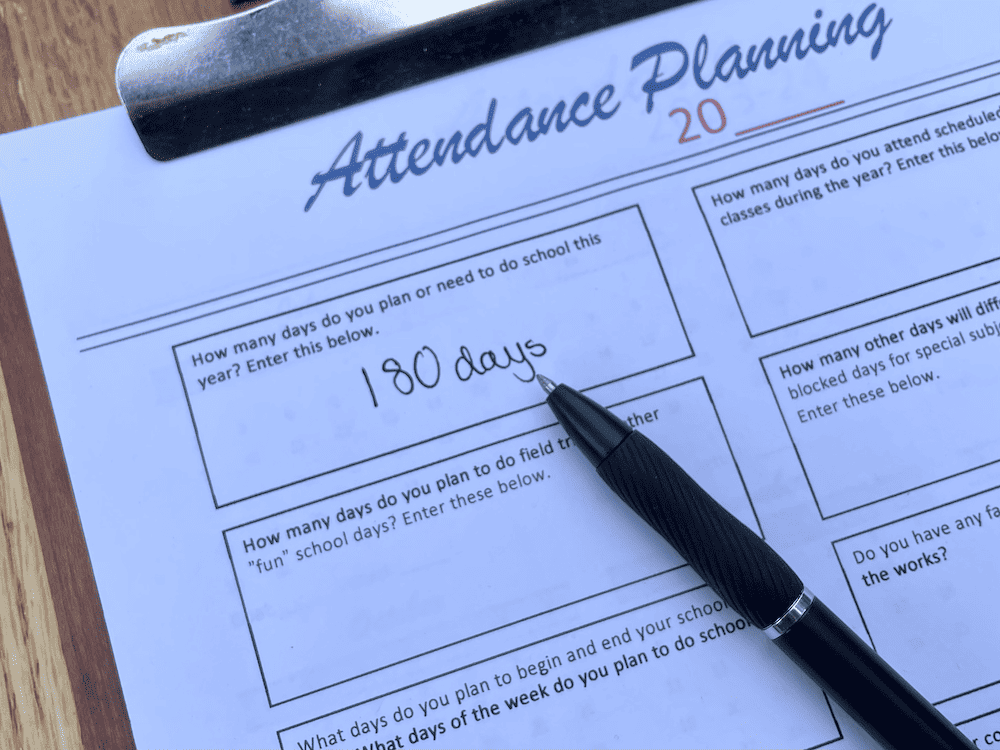
3. Decide on the number of school days
The number of school days you do in your homeschool may be dictated by your local legal requirements as mentioned above. But if you don’t have any sort of day requirement, you may come up with a number on your own. A common amount of days for a homeschool year is 180.
If your state requires hours, you may consider converting the hour requirement into days as it could be easier to track on a calendar. You could consider that one school day for your family is about 5 hours of school (including bookwork, free learning, field trips, and playtime). This would mean that if you are required to do 900 hours a year, you will need 180 days of school.
Having this number decided will be the basis for planning out your homeschool year. I note this number on my attendance planning worksheet. This page is included with my free printable homeschool attendance sheets found here.
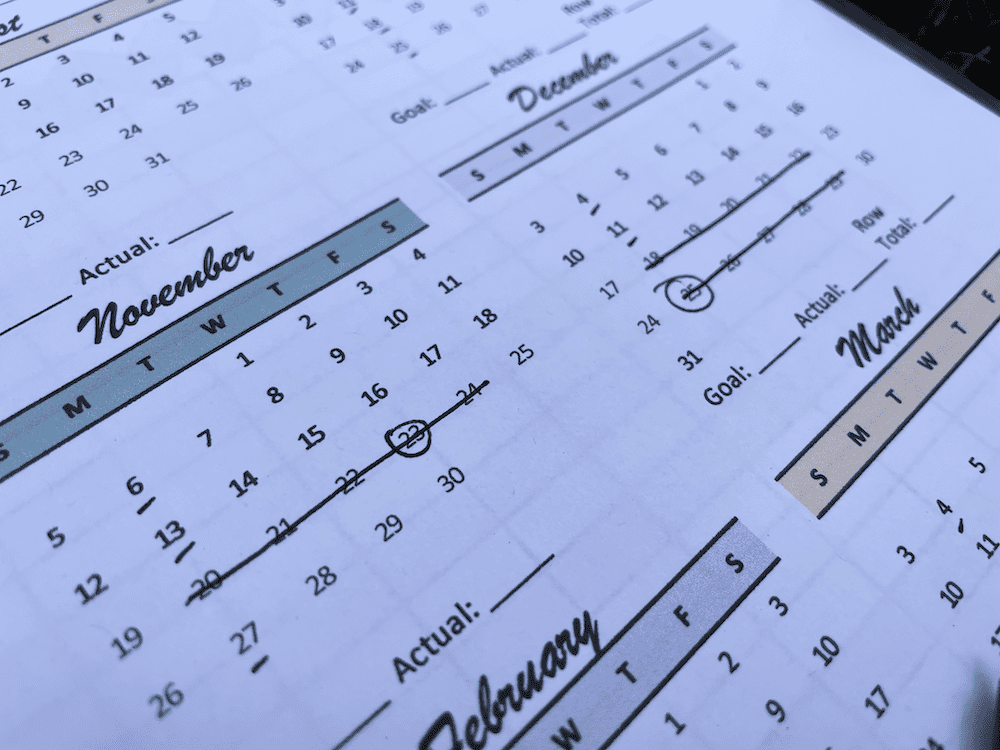
4. Cross out extended breaks and holidays
Once I have decided on the number of school days and have the attendance planning sheet filled out, it’s time to start applying this information to a calendar. I like to start with the large breaks I would like to take in our school year. This will include extended breaks like during the summer, as well as holidays, like Thanksgiving and Christmas.
On my calendar, I will actually put a line through these dates I plan to not do school. Many will take off at least a couple weeks around the holidays as well as a long break over the summer. Of course, how long this will be depends on the type of homeschool calendar you choose for your year. More on that below.
A few breaks to consider:
- Labor Day
- Fall break
- Thanksgiving break
- Christmas break
- New year
- Winter break
- Spring break
- Easter
- July 4th
- Memorial Day
- Summer break
- Birthdays
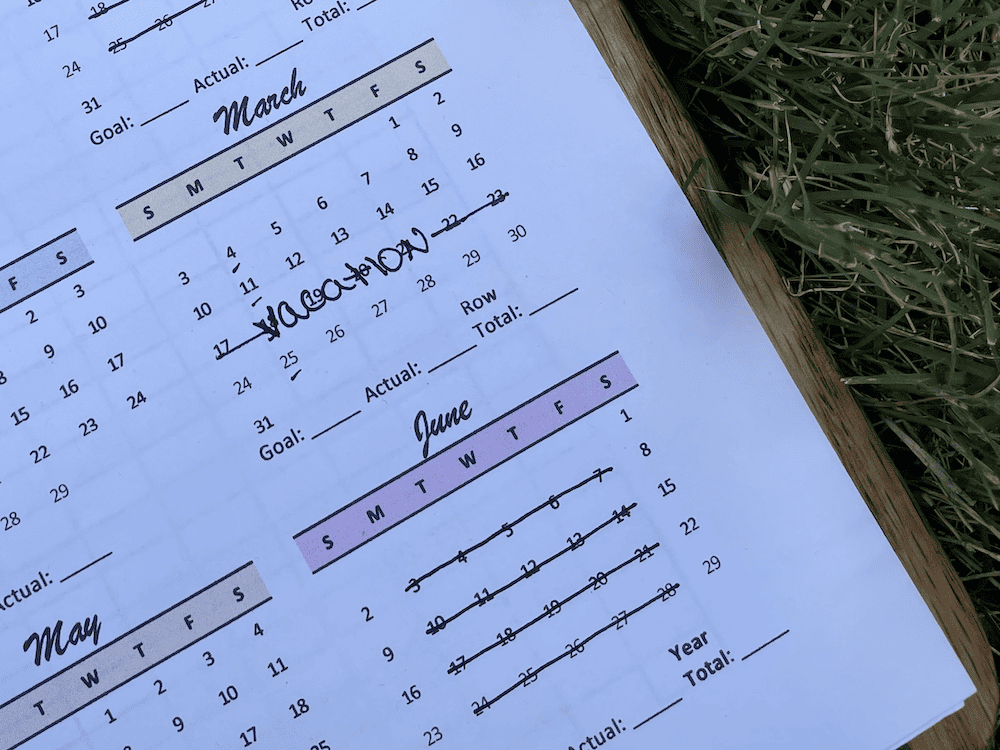
5. Mark out scheduled trips
The next step for planning your year is to mark out any (non-educational) trips that are already scheduled for your family. If you have any pre-planned trips – long or short – go ahead and cross out those days on your calendar. This will ensure you are allowing time off from school for those days.
Do you already have a vacation planned for the year? Or maybe an anniversary trip or family get together. Perhaps your extended family meets up every easter.
Of course, do consider whether at least part of these trips could count as school days. For instance, if you are visiting Washington D.C., most things you see will be educational, from museums to monuments. Those are definitely school days! Or if you are visiting another city and check out their botanical gardens, children’s museum, science museum, or any monuments or state parks. So many of these family trips could easily be counted as a homeschool field trip. Count them as school days!
As you go through the year, a trip may come up. Of course, you can add that as you need to your calendar then adjust your schedule to accommodate it.
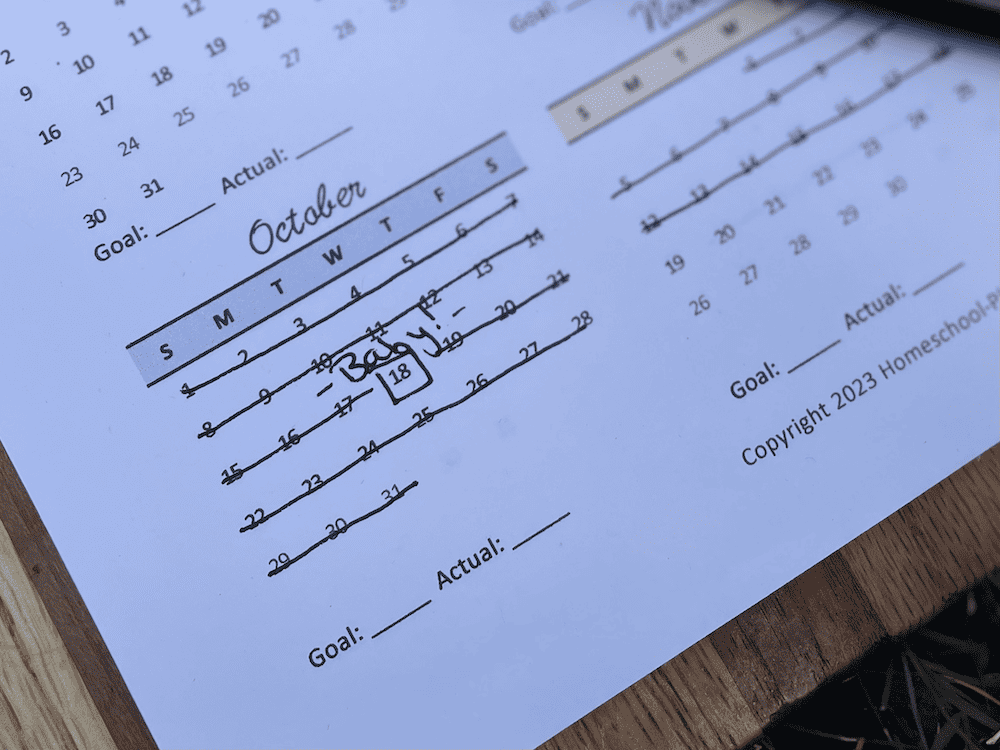
6. Consider other planned time off
I find that planning around your life is essential for homeschoolers, so you should be able to plan your year around any event that comes up. Many things aren’t known in advance, so flexibility should be used for those cases. But for those that are able to be planned around, give yourself and your kids some allowance to do so.
Some things you may want to consider in your upcoming year:
- A new baby coming
- Packing/Moving
- Medical procedures
- Surgeries
- Care for a loved one
- Wedding
- Anniversary
- Work project
- Spring cleaning
How do you allow for these things? By not scheduling school on or around these dates.
If you are expecting a new baby in mid November, then it’s ok to take November and December completely off! You may even want some of October a little flexible.
When doing this, you may end up starting your school year a little earlier to allow for this time off, or you may school more at the end of the year. Or both. The last thing you need to be doing with a new little baby in your arms is worrying about homeschooling, at least for a couple weeks!
Perhaps you are moving this year. Definitely give yourself time to house shop, pack, and unpack into your new house. There is no reason to add extra stress to an already stressful situation. Plan some weeks off.
Or if you know you have a big project coming up for your work, give yourself a few days off homeschooling to accomplish this task.
It’s ok to rearrange your homeschool schedule for life’s demands. It is your homeschool, so consider your family first. And as more curveballs are thrown at you throughout the year, adjust as needed!

7. Note scheduled classes and field trips
Marking scheduled classes and field trips on your calendar may not be necessary for planning out your school days. But it can be helpful to see them as you choose your other school days in the year. Just putting a circle around special days may help you.
For instance, if you are a part of a homeschool co-op that runs from September through April, it may be confusing to plan your homeschool year from January to October.
You may also not want to schedule one of your break weeks during a week that you will still have co-op or a field trip. Instead, you could plan your family’s breaks to coincide with your co-op breaks.
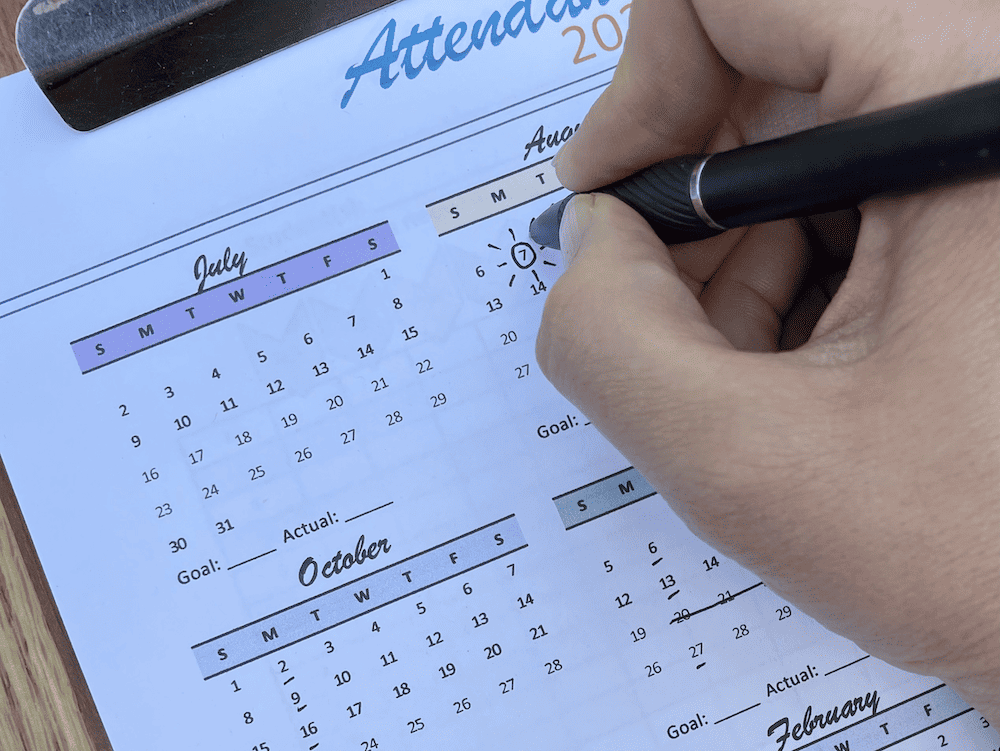
8. Pick a first day of school
Up to this point, you have looked at the days you won’t be homeschooling. Picking a first day of homeschool for your year is the first step toward actually choosing the days you will do school.
A common time to start is mid to late August, though some will wait till after labor day. Or if you like to take a lot of breaks throughout your school year, you may want to push the date back a bit to July and allow for more time off. Others will start school at the same time as their local public school, and some will even start at the beginning of January rather than the fall.
Some will start on a monday, and others will start mid-week to have a short week in the beginning.
There is no right time to start, but picking a date is essential. It can be completely arbitrary or totally chosen for a reason.
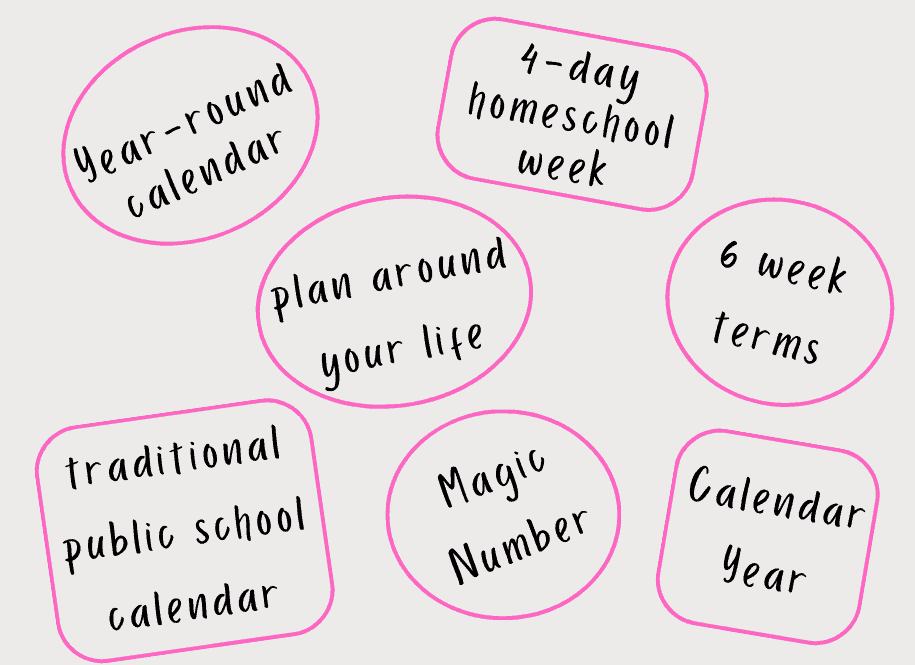
9. Pick your general calendar type
If you don’t already have an idea of the general layout of your homeschool calendar, then now is the time to decide. Your homeschool calendar is the general way you will arrange your school days and weeks, as well as your days off.
The joy of homeschooling though is that there is no one way these puzzle pieces have to go together! You can design it to fit your needs and lifestyle. This brings so much freedom to your life.
Whether you prefer a year-round schedule or one that follows the traditional public school calendar, there are several types of homeschool calendars to consider. Check out my post on homeschool calendars for more in-depth information on each of these types.
7 Types of Homeschool Calendars
- Traditional public school calendar
- Year-round schedule
- Six-week homeschool calendar (Sabbath Schooling)
- Magic Number calendar
- Four-day homeschool week
- Following the calendar year
- Plan around your life
Read: 7 Types of Homeschool Calendars and How to Plan Your Own
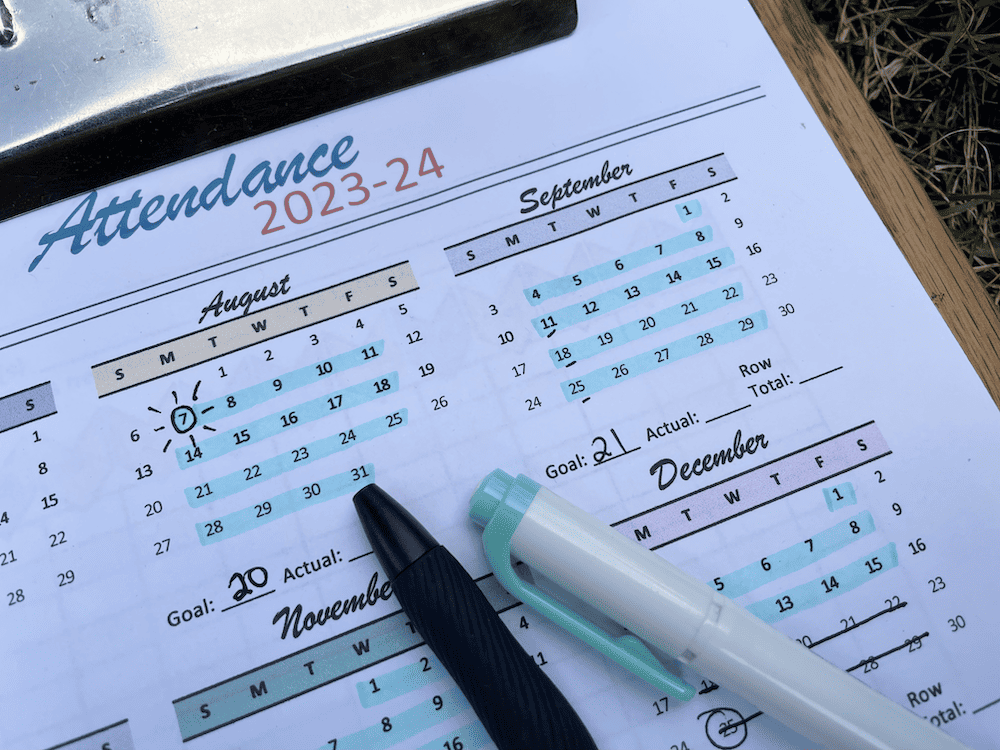
10. Schedule homeschool days
Once you have a start date chosen, and a general idea of your homeschool calendar, now we can get to the meat of planning out your homeschool attendance days!
The basic idea of this step is to apply your calendar type to your homeschool attendance sheets. Highlighting your school days works well for many. Circling could work great as well.
If you use a 6-week term schedule, you can map out these terms onto your sheet, highlighting your days of school and marking out break weeks. It may take some adjusting of your break weeks or even of your start date to get all things jiving well.
I like to write a total goal of school days for each month as I plan them out. This helps me have another way to monitor our progress as we go. I also am sure that all these monthly totals add up to the correct end-of-year goal that I set in step 3. For us, this is 180 days.
Using these monthly goal totals is also a way to help you follow the magic number calendar type for your homeschool year. If you would rather not commit to schooling on specific days, setting a total number of days for the month is helpful to still meet your annual goal.
With this approach, you wouldn’t mark the days you plan to homeschool in advance but just complete the total number at some point by the end of the month. This is how I plan out attendance in our homeschool.
No matter how you plan out your year in advance, be sure to track your actual school days as you go. This can be done on this same calendar you create by highlighting or marking your actual school days.
If you mark your planned days in one color (pink), you could mark your actual schooling days in another (blue). This could create a third color (purple!) on the days you accomplish your plan, just for funsies!
When you mark and total the days of school you accomplished, it can really help you feel accomplished with a visual! Be sure to total up those days too so you can show your completed attendance record at the end of the year!
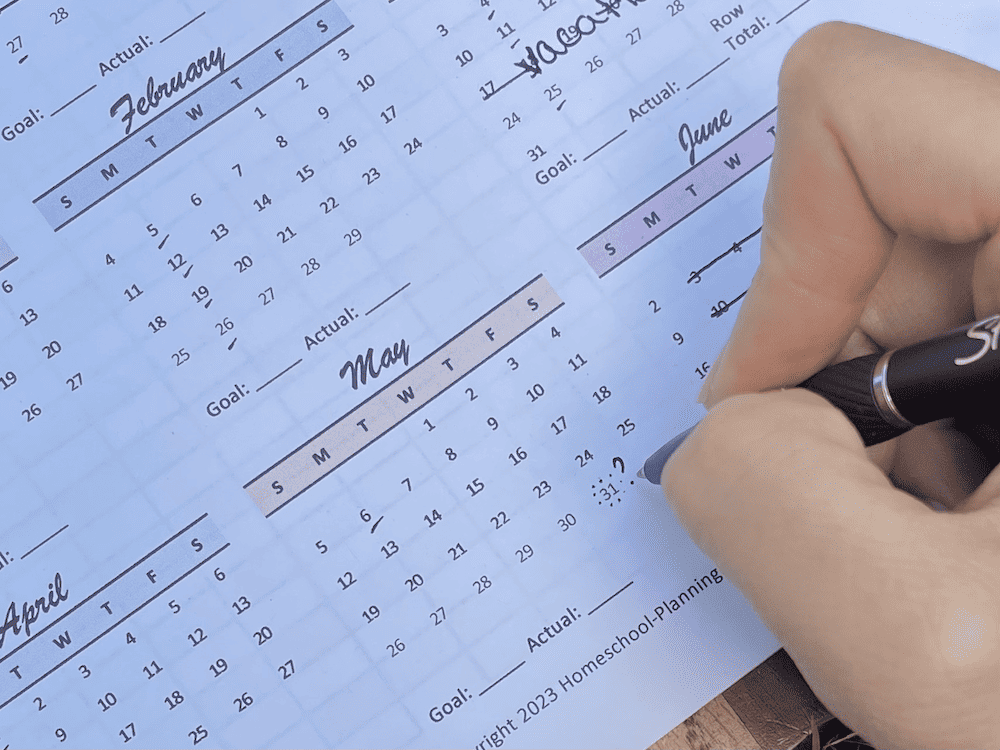
11. Choose a tentative last day of school
When planning your school days out in advance, I highly suggest you choose the last day tentatively. Things rarely go to plan, and holding that date loosely will allow some flexibility in your homeschool. Anything can happen in a school year to mess things up.
So you can lightly mark a goal date to finish your year. Having a goal is helpful so you aren’t too loose either.
Read: How to Finish Strong This Homeschool Year
Once I get within the last couple months of our school year – March or so for us – I will think a little harder about marking a more definite date. But I tell you, those last couple weeks of school can be rough when you just want to be done. So give yourself some grace!
Once you get this date set, that’s it! Congrats! You should now have a set homeschool attendance calendar for your year!

Free Printable Homeschool Attendance Sheets
Download your worksheets today and get started on planning out your year.
Helpful tips for using these worksheets:
- Print out the free printable homeschool attendance sheets
- Fill out in pencil or erasable pen in case you make a mistake
- Print multiple copies of the calendar in case of mistakes
- Use a final draft of the calendar to reference throughout the year
- Track your daily attendance – highlighters work well
- Feel free to adjust as needed throughout the year
Final thoughts
Having a plan for your homeschool year using free printable homeschool attendance sheets will get you off to a good start! It will help you meet your goals for the year and create some consistency in your schedule. Following these 11 steps to plan your homeschool attendance in advance makes it easy get started on your homeschool planning journey.
Happy homeschooling!
Related posts
Homeschool Attendance Records: Days and Hours (The Ultimate Guide)
7 Types of Homeschool Calendars and How to Plan Your Own
The Most Vital Tool in Your Homeschool Schedule


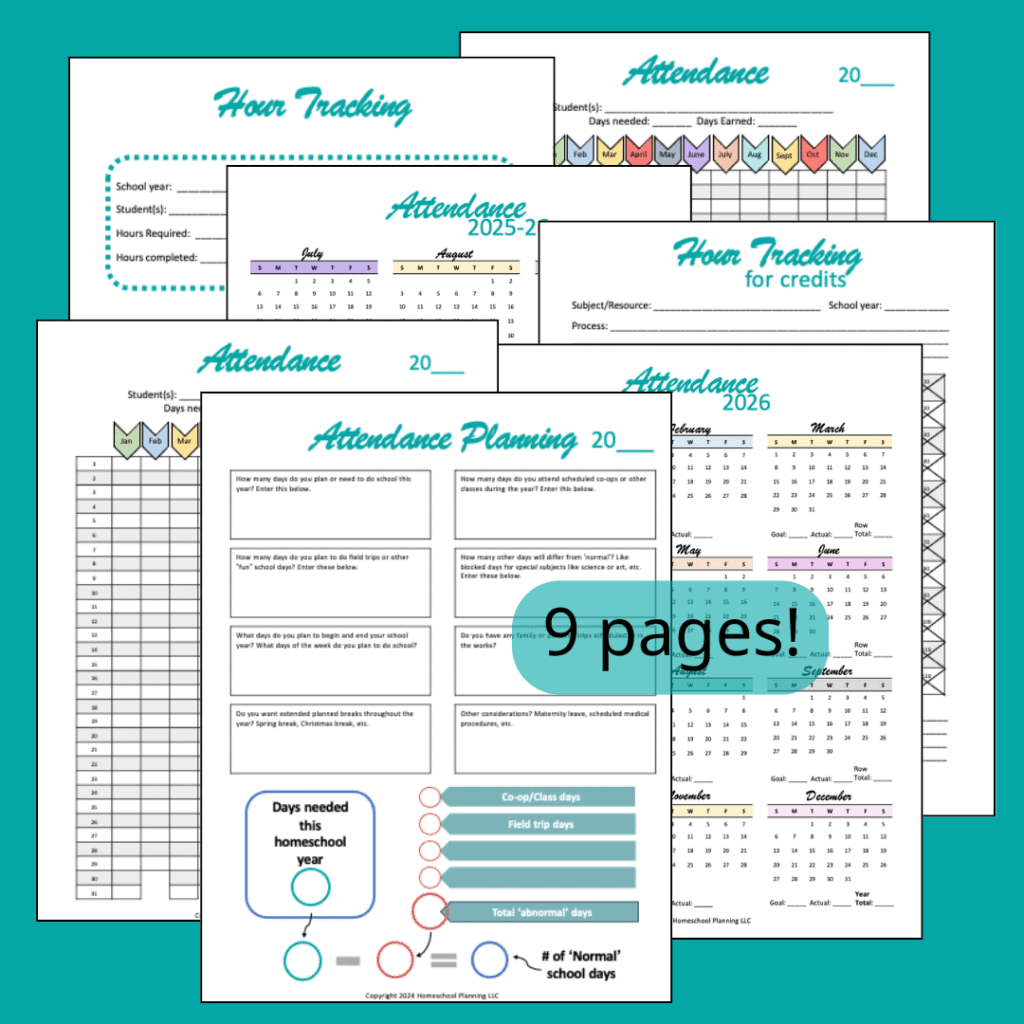



Sites to printables don’t work
I’m sorry you’re having trouble accessing the printables! To get the printables, this is the link that should take you there: https://homeschool-planning.com/calendar
Hope that works for you!